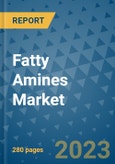Market Insights
Fatty amines, nitrogen-based derivatives of fatty acids and olefins, play a significant role in several industrial and consumer sectors. Derived from raw materials such as vegetable oils, animal fats, and petrochemicals, these amines are classified into primary, secondary, and tertiary types, depending on their molecular structure. They are valued for their water-repellent, emulsifying, and antimicrobial properties.Fatty amines contribute a significant share to the global oleochemicals industry and are extensively used in agrochemicals, water treatment, personal care, construction, textiles, and oilfield chemicals. Their increasing relevance in environmental sustainability and efficiency has catalyzed demand from both developed and developing nations.
Market Drivers
A primary factor propelling the fatty amines market is the rising demand from the agrochemical sector. With the need to enhance agricultural productivity to support the growing global population, the role of agrochemicals has become more critical. Fatty amines are used as anti-caking agents in fertilizers, helping maintain their quality and effectiveness. Additionally, their water-repellent properties are useful in pesticide formulations, enhancing crop protection.Water treatment is another strong driver. With escalating concerns over water pollution and industrial wastewater disposal, fatty amines are gaining traction as corrosion inhibitors, disinfectants, and biocides in water treatment processes. Their ability to neutralize harmful microorganisms and reduce environmental pollutants has made them vital in both public utilities and private industrial facilities.
Business Opportunity
The growth potential in emerging markets such as India and China offers lucrative opportunities for manufacturers. India, for instance, is experiencing significant losses in agricultural productivity due to pest infestations and soil degradation. This has led to increased demand for agrochemicals, thereby boosting the consumption of fatty amines.Moreover, India’s low manufacturing costs, skilled labor availability, and strong export positioning make it an attractive destination for international players seeking production expansion. Similarly, China’s robust infrastructure development and expanding industrial sector are generating significant demand for water treatment chemicals, where fatty amines play a crucial role.
Technological innovation is also creating avenues for market expansion. Companies are investing in R&D and strategic partnerships to develop new applications and improve process efficiencies. For example, the integration of fatty amines into sustainable product formulations for personal care and homecare is expanding their reach beyond traditional industries.
Regional Analysis
Asia-Pacific remains the dominant region in the global fatty amines market, primarily driven by rapid industrialization, urban development, and strong demand from agrochemical and water treatment sectors. Countries such as China and India are at the forefront of this growth due to infrastructure development, rising population, and increasing food security challenges.North America continues to witness growth supported by technological advancements and a mature agrochemical market. Additionally, increased environmental regulations and focus on sustainable agricultural practices have spurred demand for biocide-enhanced fertilizers and treated water solutions containing fatty amines.
Europe is also showing healthy progress in the market, especially in the construction and personal care sectors. Environmental awareness and regulatory frameworks across the region are pushing industries toward the adoption of eco-friendly chemical solutions, further driving demand for fatty amines.
Key Players
The fatty amines market is moderately fragmented, with global and regional players actively expanding their footprint through acquisitions, joint ventures, and capacity expansion projects. Prominent companies include:- Akzo Nobel N.V.
- Evonik Industries AG
- Kao Corporation
- Clariant AG
- Arkema S.A.
- Solvay S.A.
- Albemarle Corporation
- Indo Amines Ltd
- Procter & Gamble
- Lonza Group Ltd
- Eastman Chemicals
- Sterling Auxiliaries Pvt. Ltd.
- NOF CORPORATION
- Wuxi Zhufeng Fine Chemical Co., Ltd.
- Nouryon
Fatty Amines Market Segmentation
By Product Type:
- Primary Fatty Amines
- Secondary Fatty Amines
- Tertiary Fatty Amines
By Application:
- Agrochemicals
- Water Treatment
- Personal Care
- Construction
- Oil Field Chemicals
- Textile Industry
- Others
By Region:
- North America
- Latin America
- Europe
- Asia Pacific
- Middle East & Africa
This product will be delivered within 1-3 business days.
Table of Contents
Companies Mentioned
- Cargill Incorporated
- DuPont
- Ingrideon Incorporated
- Merck KGaA
- Mitsubishi Shoji Foodtech
- Novagreen Inc.
- Roquette Freres
- Shandong Futaste Co.
- Thomson Biotech (Xiamen) Co., Ltd.
- ZuChem
- Zhejiang Huakang Pharmaceutical Co.
- CSPC Shengxue Glucose Co., Ltd.
- DFI Corp.
- JiningHengda Green Engineering Co., Ltd.








